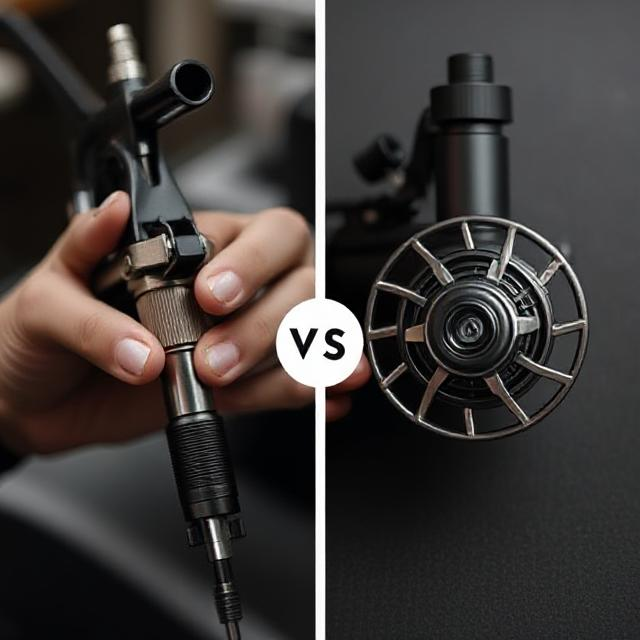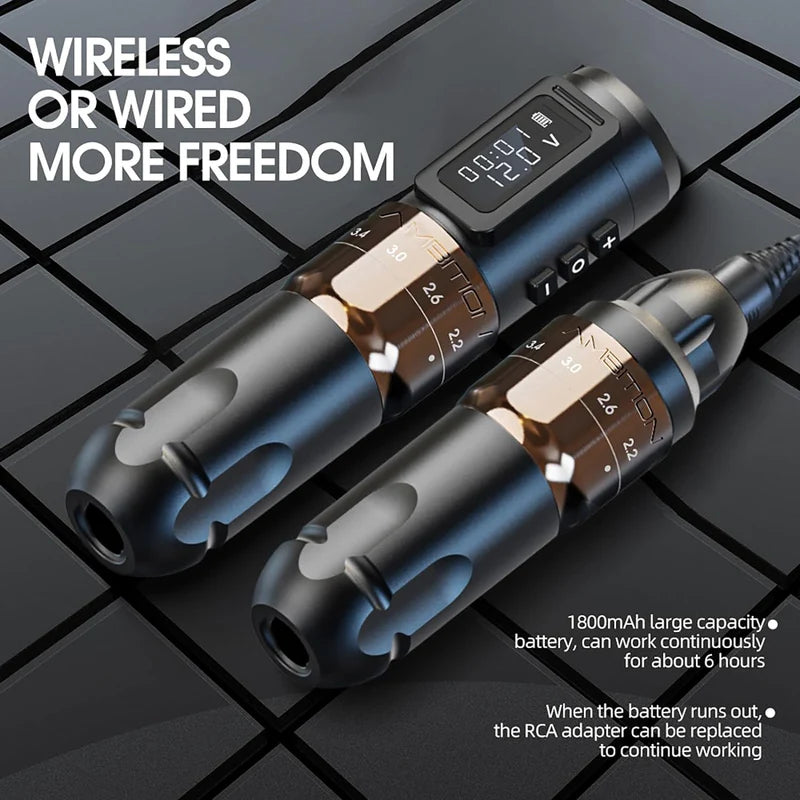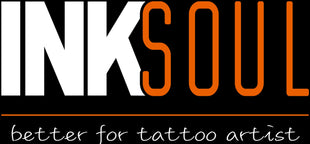News

Coil Tattoo Machine
Coil Tattoo Machine vs. Rotary: Which One Is Right for You?
Table of Contents
Introduction to Tattoo Machines
Understanding Coil Tattoo Machines
2.1 How Coil Tattoo Machines Work
2.2 Pros and Cons of Coil Tattoo Machines
Understanding Rotary Tattoo Machines
3.1 How Rotary Tattoo Machines Work
3.2 Pros and Cons of Rotary Tattoo Machines
Coil vs. Rotary: Key Differences
Which Tattoo Machine is Best for You?
Introducing the Dragonhawk Wireless Tattoo Pen Machine
FAQs About Coil and Rotary Tattoo Machines
Conclusion and Summary Table
1. Introduction to Tattoo Machines
Tattoo artists rely on high-quality machines to create detailed, lasting designs. Among the most commonly used tattoo machines are coil and rotary machines, each offering distinct benefits and working mechanisms.
In this article, we’ll explore the differences between coil and rotary tattoo machines, their advantages and disadvantages, and help you determine which machine suits your style.
2. Understanding Coil Tattoo Machines
2.1 How Coil Tattoo Machines Work
A coil tattoo machine operates using electromagnetic coils that move a spring-loaded armature bar, which drives the attached tattoo needle up and down. The machine works by rapidly turning the coils on and off, creating a powerful hammering motion.
2.2 Pros and Cons of Coil Tattoo Machines
Pros:
Powerful & Precise: Coil machines offer stronger needle penetration, making them ideal for thick lines and deep shading.
Better Ink Saturation: The powerful up-and-down motion allows for better pigment embedding in the skin.
Customizable: Artists can modify the machine’s springs, coils, and armature bars for tailored performance.
Affordable: Generally, coil machines are cheaper than rotary machines.
Cons:
Heavier & Noisier: Due to the electromagnetic mechanism, coil machines are heavier and louder, which may cause hand fatigue.
Requires Regular Maintenance: The many mechanical parts need frequent tuning and adjustments.
Steeper Learning Curve: The power and weight make coil machines harder to master, especially for beginners.
3. Understanding Rotary Tattoo Machines
3.1 How Rotary Tattoo Machines Work
A rotary tattoo machine uses a small electric motor to move the tattoo needle in a smooth, continuous motion. Unlike coil machines, which use electromagnetic pulses, rotary machines provide a fluid motion, making them gentler on the skin.
3.2 Pros and Cons of Rotary Tattoo Machines
Pros:
Lightweight & Quiet: Rotary machines are lighter and quieter, reducing artist fatigue.
Less Skin Damage: The smooth motion minimizes trauma to the skin, resulting in faster healing times.
Versatile: Rotary machines can be used for lining, shading, and coloring without the need for frequent adjustments.
Beginner-Friendly: The steady and consistent motion makes it easier to learn compared to coil machines.
Cons:
Less Customization: Rotary machines don’t allow as many adjustments or modifications as coil machines.
Less Power for Thick Lines: The gentle motion makes packing in solid black or heavy shading harder compared to coil machines.
More Expensive: High-quality rotary machines often come at a higher price point than coil machines.
4. Coil vs. Rotary: Key Differences
Feature
Coil Tattoo Machine
Rotary Tattoo Machine
Mechanism
Uses electromagnetic coils
Uses an electric motor
Weight
Heavy
Lightweight
Noise Level
Loud buzzing sound
Quiet
Skin Impact
More trauma
Less trauma
Ink Saturation
Better for bold lines & deep shading
Softer shading, smooth transitions
Versatility
Best for lining & shading separately
Can be used for lining, shading, and color packing
Maintenance
Needs frequent tuning
Low maintenance
Ease of Use
Harder for beginners
Beginner-friendly
Cost
Affordable
More expensive
5. Which Tattoo Machine is Best for You?
If you need powerful ink saturation and bold lines, choose a coil tattoo machine.
If you want a lightweight, low-maintenance, and versatile machine, a rotary machine is ideal.
Beginners should start with a rotary machine due to its ease of use and less skin trauma.
Experienced tattoo artists may prefer a coil machine for precision and deeper penetration.
6. Introducing the Dragonhawk Wireless Tattoo Pen Machine
If you’re looking for an advanced rotary tattoo machine, the Dragonhawk Wireless Tattoo Pen Machine is a top choice.
Key Features of the Dragonhawk Wireless Tattoo Pen Machine:
Next-Generation Body Craftsmanship: Designed to be lightweight, compact, and easy to handle.
Versatile for All Tattoo Styles: Adjustable frequency settings allow tattoo artists to work across different styles and techniques.
Advanced Brushless Motor: Features a 10V/9000RPM brushless motor for superior power, stability, and low noise levels.
Superior Performance: Excels in durability, consistency, and low skin damage.
This machine is an excellent choice for artists who want the precision of a rotary machine with adjustable performance settings.
7. FAQs About Coil and Rotary Tattoo Machines
Q1: Are coil tattoo machines better than rotary machines?
It depends on the tattooing style. Coil machines offer better ink saturation and bold lines, while rotary machines provide smoother shading and versatility.
Q2: Can beginners use coil tattoo machines?
Yes, but coil machines are harder to master. Most beginners start with a rotary machine due to its ease of use.
Q3: Do rotary tattoo machines hurt less?
Yes, rotary machines cause less trauma to the skin, making them less painful than coil machines.
Q4: Which machine lasts longer, coil or rotary?
Both are durable, but coil machines require more maintenance. Rotary machines have fewer moving parts, making them easier to maintain.
Q5: Can I use the Dragonhawk Wireless Tattoo Pen for shading and lining?
Yes! The Dragonhawk Wireless Tattoo Pen Machine is designed for all tattoo styles, including lining, shading, and color packing.
8. Conclusion and Summary Table
Both coil and rotary tattoo machines have unique advantages. Coil machines are powerful and precise, making them perfect for bold lines and deep shading. Rotary machines are lightweight, quiet, and versatile, making them ideal for smooth shading and faster healing times.
Here’s a summary of the key differences:
Factor
Coil Tattoo Machine
Rotary Tattoo Machine
Best for
Bold lines, deep shading
Smooth shading, all styles
Weight
Heavy
Lightweight
Noise Level
Loud
Quiet
Ease of Use
Difficult for beginners
Beginner-friendly
Skin Impact
More trauma
Less trauma
Customization
High
Low
Price
Affordable
More expensive
Maintenance
Requires tuning
Low maintenance
For those seeking an advanced rotary machine, the Dragonhawk Wireless Tattoo Pen Machine offers unparalleled performance, versatility, and ease of use.
Whether you choose a coil or rotary tattoo machine, the most important factor is finding the right tool for your tattooing style and comfort. Happy tattooing! 🎨

Rotary Tattoo Machine
Rotary Tattoo Machine: How It Works and Why It’s Essential for Artists
Rotary Tattoo Machine: How It Works and Why It’s Essential for Artists
A comprehensive guide to understanding rotary tattoo machines, their benefits, and top features.
Table of Contents
Introduction
How a Rotary Tattoo Machine Works
Key Features of a Rotary Tattoo Machine
Spotlight: Ambition MARS-U Wireless Tattoo Machine
Benefits of Using Rotary Tattoo Machines
FAQs
Comparison Table of Features
Introduction
Rotary tattoo machines have revolutionized the tattooing industry by offering precise, smooth, and quiet performance. Unlike traditional coil machines, rotary machines use a motor-driven mechanism that simplifies operation and improves consistency. This article dives deep into how rotary tattoo machines work, their unique features, and why they are favored by professional tattoo artists worldwide.
How a Rotary Tattoo Machine Works
At its core, a rotary tattoo machine uses a rotating motor to drive the needle up and down. This motion is smoother and more consistent compared to coil machines, which rely on electromagnetic coils to create a pulsing effect.
Key Mechanisms
Motor: The motor powers the needle's linear motion.
Cam Wheel: Converts the motor's rotary motion into linear motion for the needle.
Needle Bar: Connected to the cam wheel, it drives the needle into the skin.
Rotary machines are ideal for all tattooing styles, including lining, shading, and coloring, due to their versatility and adjustable stroke lengths.
Key Features of a Rotary Tattoo Machine
Quiet Operation: Rotary machines produce less noise, creating a more relaxed environment for both the artist and the client.
Lightweight Design: Easier to handle for long tattooing sessions.
Adjustable Stroke: Many rotary machines allow for stroke adjustments, enabling precise control for different tattoo styles.
Spotlight: Ambition MARS-U Wireless Tattoo Machine
The Ambition MARS-U Wireless Tattoo Machine is a top choice for professional artists due to its advanced features and superior performance.
Specifications:
Material: Aluminium alloy frame with CNC carving.
Motor: Coreless motor, 10V - 9000 RPM.
Output Voltage: 5V-12V.
Operation Time: Approximately 6 hours.
Battery: 1800mAh, charges in about 2 hours.
Adjustable Strokes: 2.2mm to 4.2mm stroke length, easily changeable using the adjustment knob.
With its customizable stroke lengths, the Ambition MARS-U excels in creating soft black and gray shading, making it a versatile and reliable tool for any artist.
Benefits of Using Rotary Tattoo Machines
Versatility: Suitable for all tattoo styles, from fine lines to intricate shading.
Efficiency: Reduces fatigue with its lightweight and ergonomic design.
Consistency: Ensures smooth and even needle movement, reducing trauma to the skin.
FAQs
1. How do I maintain my rotary tattoo machine?
Regularly clean and sterilize the machine, lubricate moving parts, and inspect for wear and tear to ensure optimal performance.
2. Can rotary tattoo machines be used by beginners?
Yes, their simple design and ease of use make them a great choice for novice tattoo artists.
3. What is the ideal stroke length for shading?
For shading, a longer stroke length (around 3.8mm to 4.2mm) is recommended for smoother gradients.
Comparison Table of Features
Machine Name
Motor Type
Stroke Length
Battery Life
Special Features
Ambition MARS-U
Coreless Motor
2.2mm - 4.2mm
6 hours
Wireless, Adjustable Stroke
